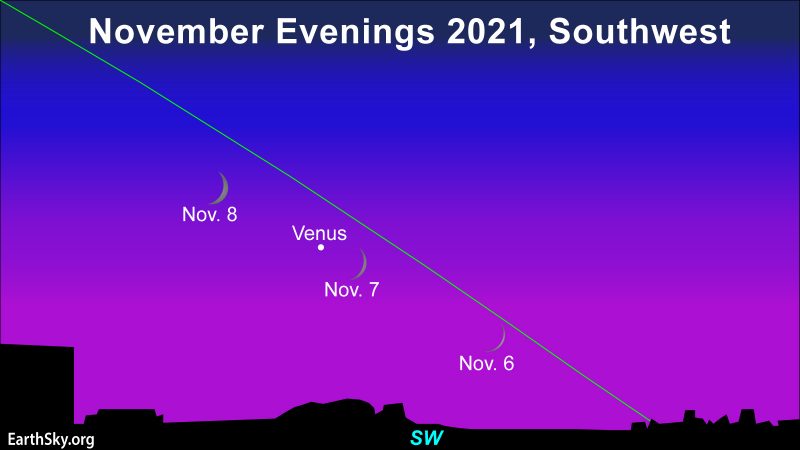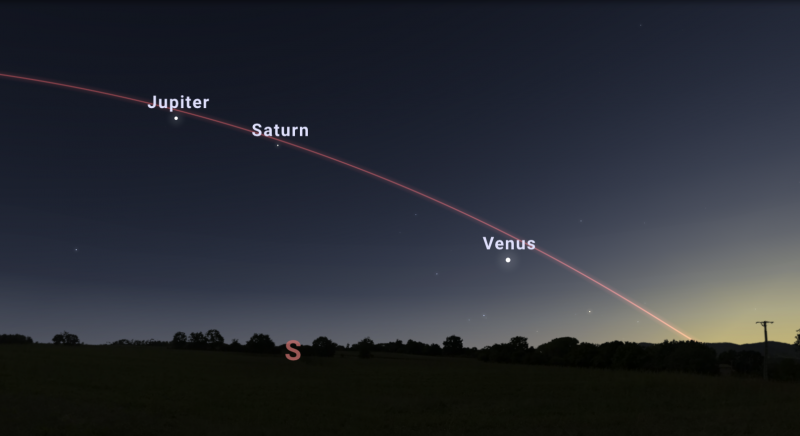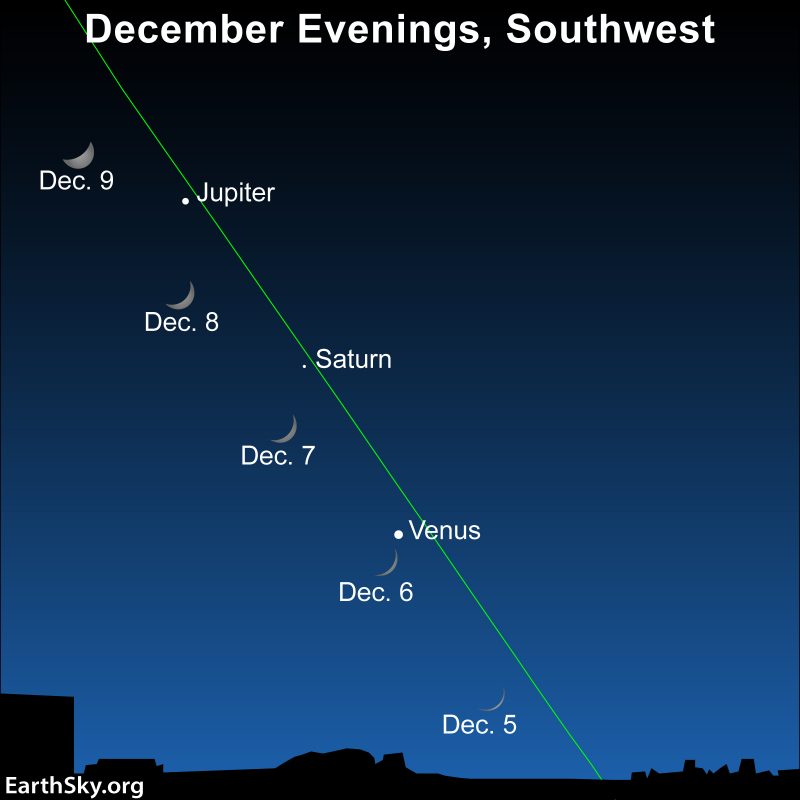
Fresh from its greatest elongation (greatest distance from the sun on our sky’s dome) on October 29, Venus is easily seen from across Earth throughout November, 2021.
For Southern Hemisphere skywatchers, this is an excellent to time to view Venus. Try the evening of November 6, when the moon will be a very slim crescent – a young moon – just above the sunset point. By the evening of November 7, the moon will be a fatter crescent, setting longer after the sun, very near Venus. On the next evening, November 8, the star-forming nebula M8 might be in reach, with optical aid. It’ll be glowing subtlely just beyond the moon’s dark side. Binoculars will enhance the scene.
For Northern Hemisphere skywatchers, Venus will appear lower in the sky, more to one side (the left side) of the sunset point. But Venus will remain a dazzling light in our sunset direction throughout November, 2021. We in the north will also see the moon slide past Venus on the evenings of November 7 and 8, 2021. Northern viewers might see the very thin waxing crescent moon on November 6 as well. For a special view, use binoculars to place the moon and Venus in the same field. You’ll also see earthshine, a mysterious glow on the moon’s night side.
For us in the Northern Hemisphere, the view of Venus will improve throughout November. That seems paradoxical since Venus has reached the end of its tether with respect to the sun; its distance from the sun is now decreasing. Yet the view improves because, as Earth moves around the sun, the evening angle of the ecliptic – or path of the sun, moon and planets in our sky – is shifting upward. The effect is to carry Venus higher in the west after sunset.


Bottom line: The moon will sweep past Venus on the evenings of November 7 and 8, 2021. Try November 6, too, when the moon will be just emerging from the sunset glare.
The post Moon and Venus November 6, 7 and 8 first appeared on EarthSky.
from EarthSky https://ift.tt/3mLbWY1

Fresh from its greatest elongation (greatest distance from the sun on our sky’s dome) on October 29, Venus is easily seen from across Earth throughout November, 2021.
For Southern Hemisphere skywatchers, this is an excellent to time to view Venus. Try the evening of November 6, when the moon will be a very slim crescent – a young moon – just above the sunset point. By the evening of November 7, the moon will be a fatter crescent, setting longer after the sun, very near Venus. On the next evening, November 8, the star-forming nebula M8 might be in reach, with optical aid. It’ll be glowing subtlely just beyond the moon’s dark side. Binoculars will enhance the scene.
For Northern Hemisphere skywatchers, Venus will appear lower in the sky, more to one side (the left side) of the sunset point. But Venus will remain a dazzling light in our sunset direction throughout November, 2021. We in the north will also see the moon slide past Venus on the evenings of November 7 and 8, 2021. Northern viewers might see the very thin waxing crescent moon on November 6 as well. For a special view, use binoculars to place the moon and Venus in the same field. You’ll also see earthshine, a mysterious glow on the moon’s night side.
For us in the Northern Hemisphere, the view of Venus will improve throughout November. That seems paradoxical since Venus has reached the end of its tether with respect to the sun; its distance from the sun is now decreasing. Yet the view improves because, as Earth moves around the sun, the evening angle of the ecliptic – or path of the sun, moon and planets in our sky – is shifting upward. The effect is to carry Venus higher in the west after sunset.


Bottom line: The moon will sweep past Venus on the evenings of November 7 and 8, 2021. Try November 6, too, when the moon will be just emerging from the sunset glare.
The post Moon and Venus November 6, 7 and 8 first appeared on EarthSky.
from EarthSky https://ift.tt/3mLbWY1

Aucun commentaire:
Enregistrer un commentaire